Charles E W Bean, Diaries, AWM38 3DRL 606/247/1 - 1917 - 1933 - Part 15
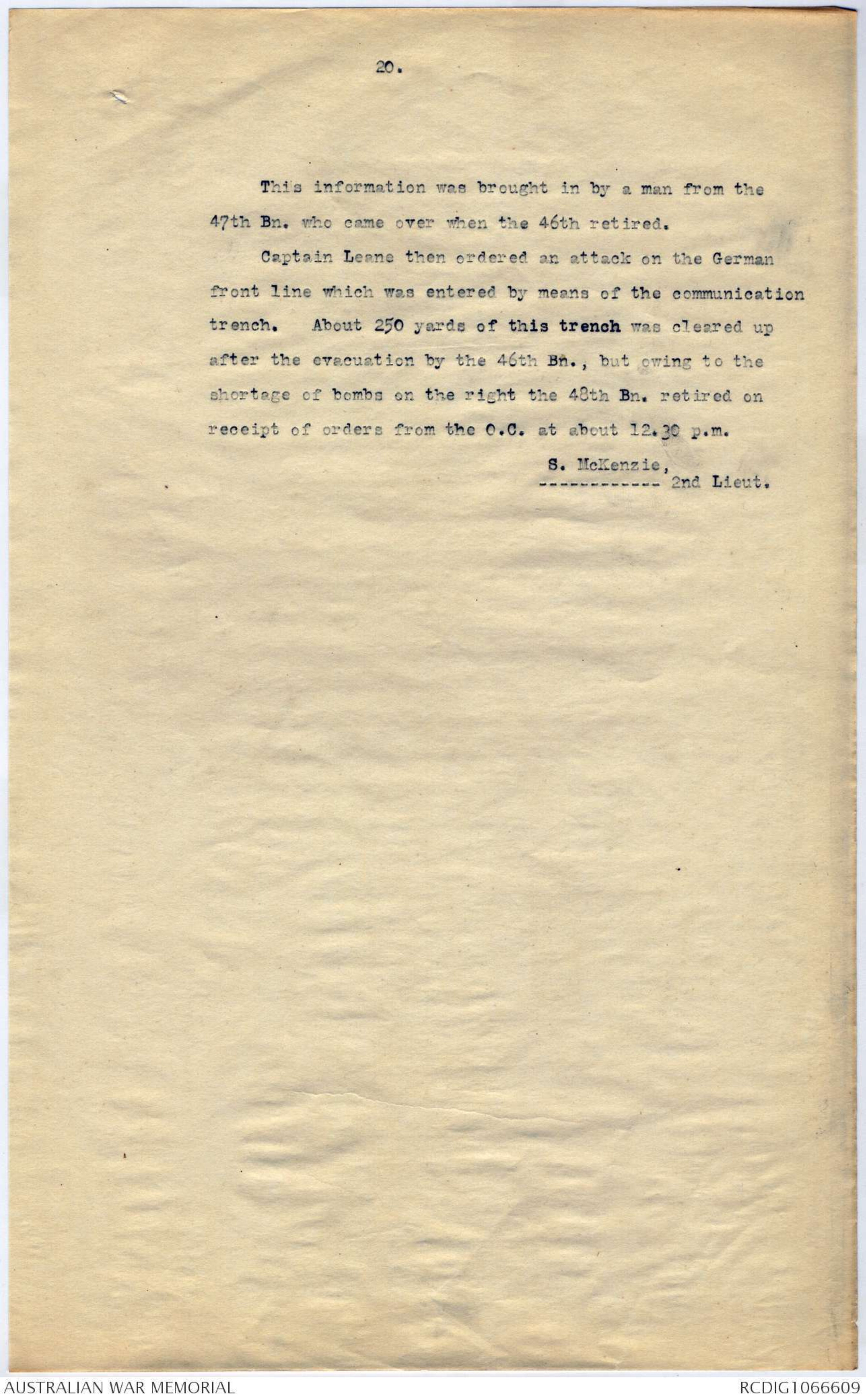

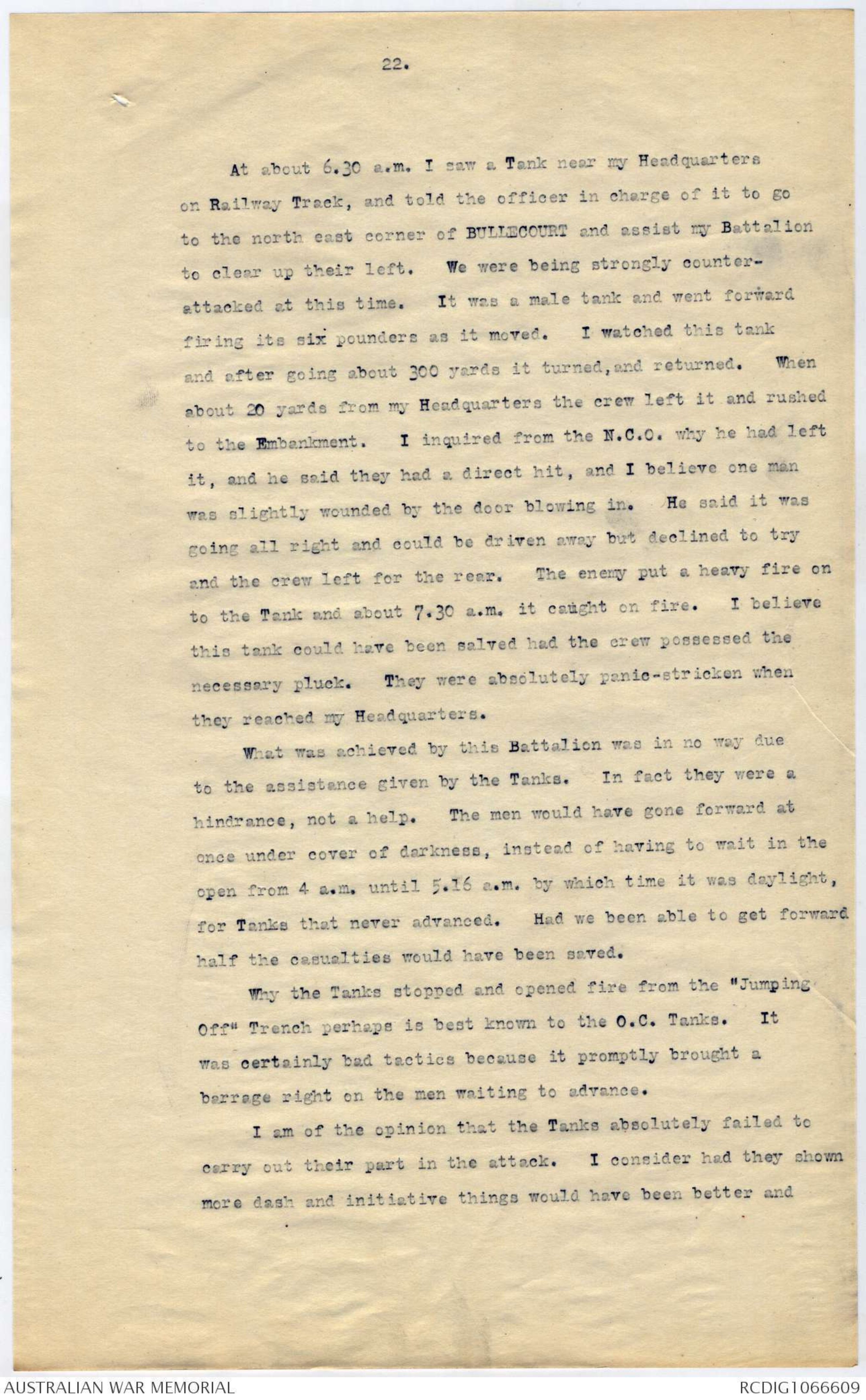
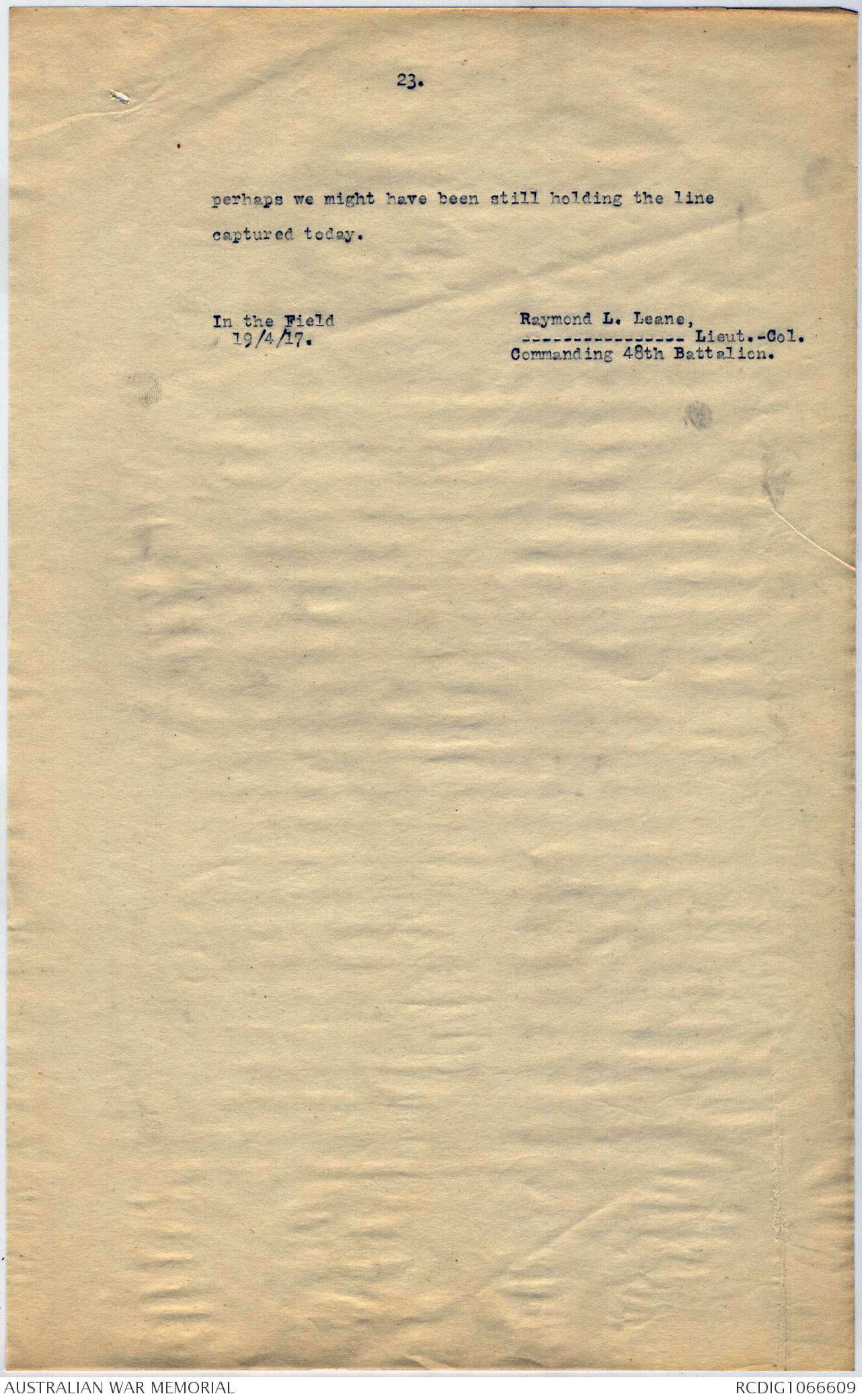
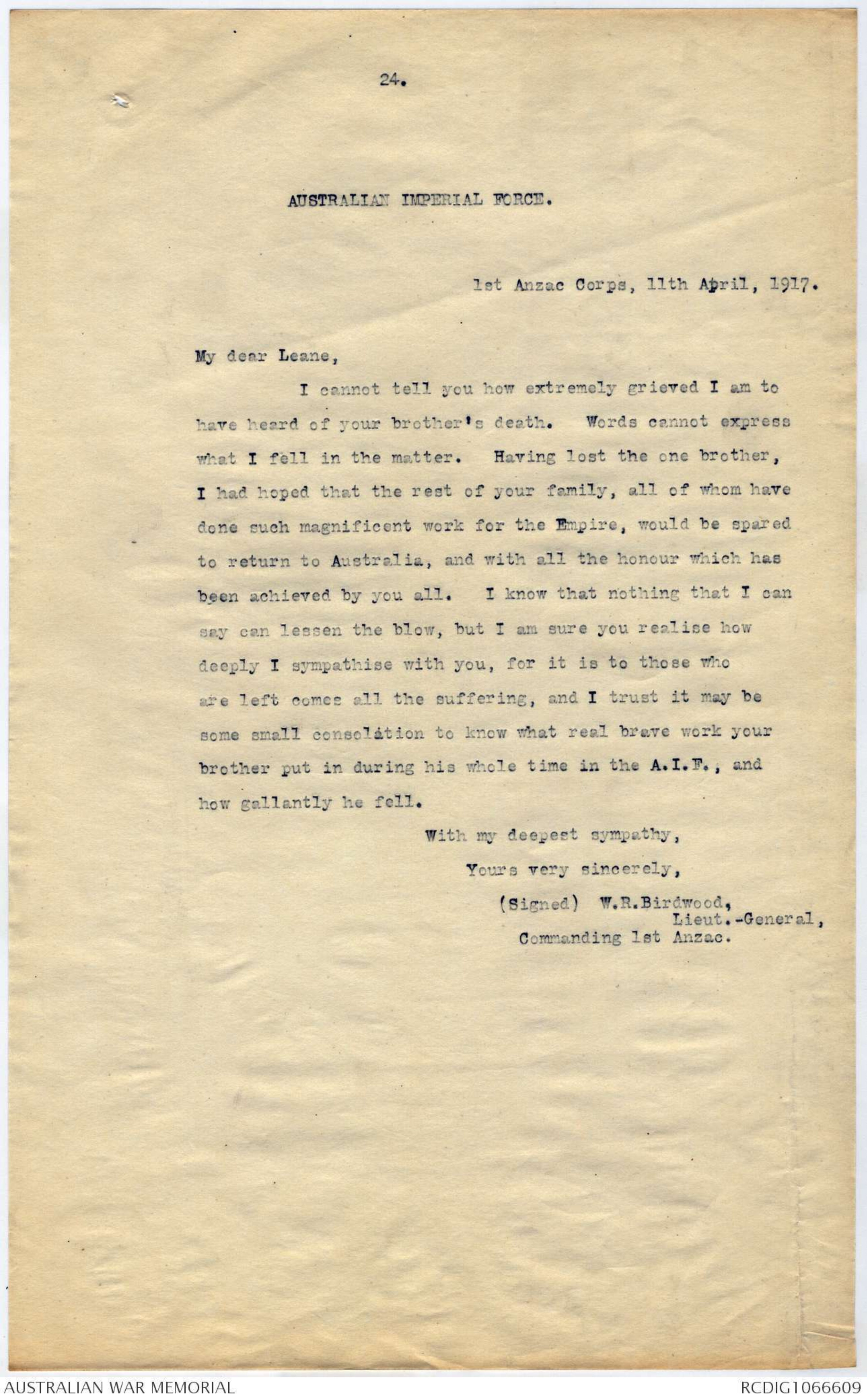
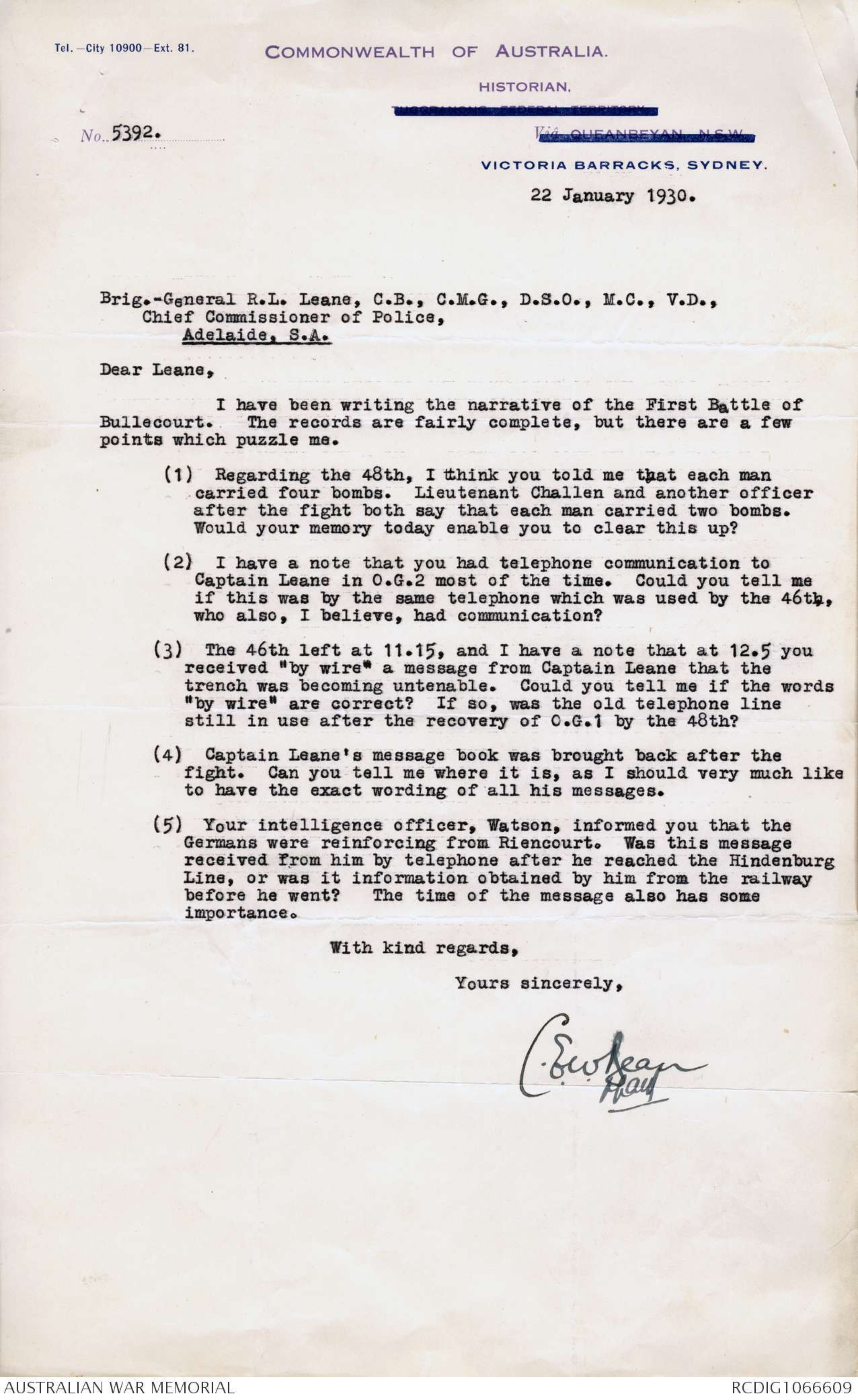
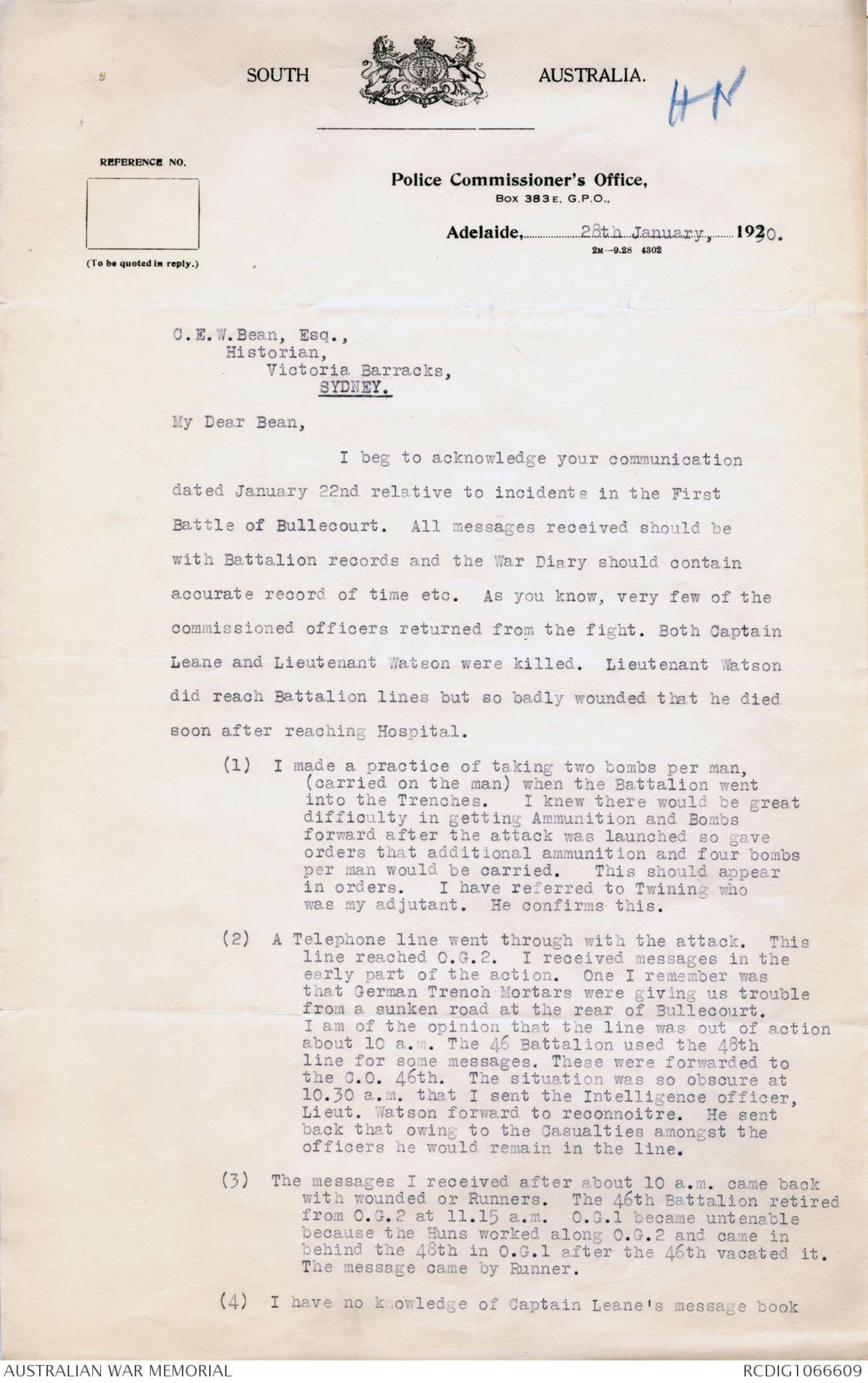
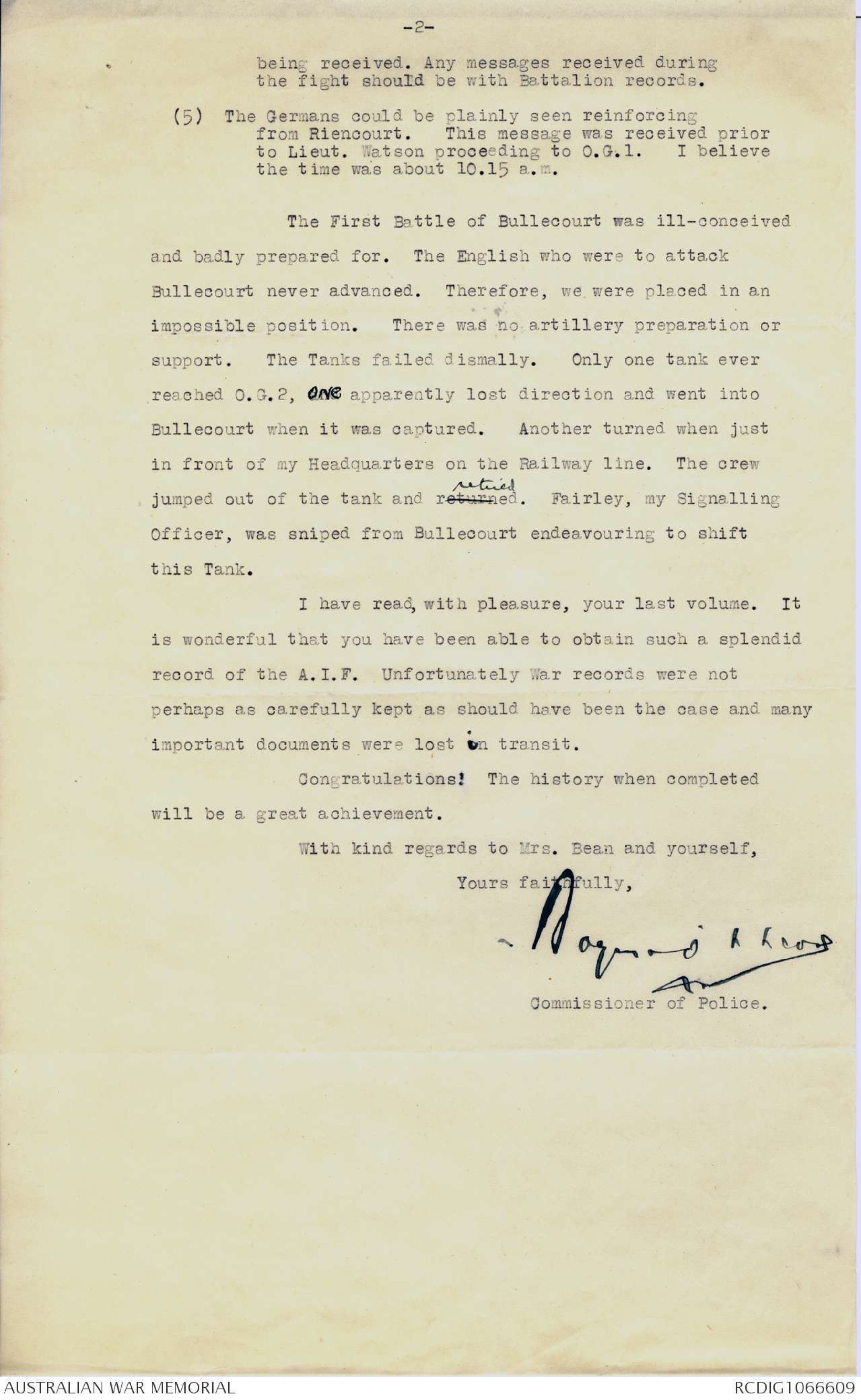
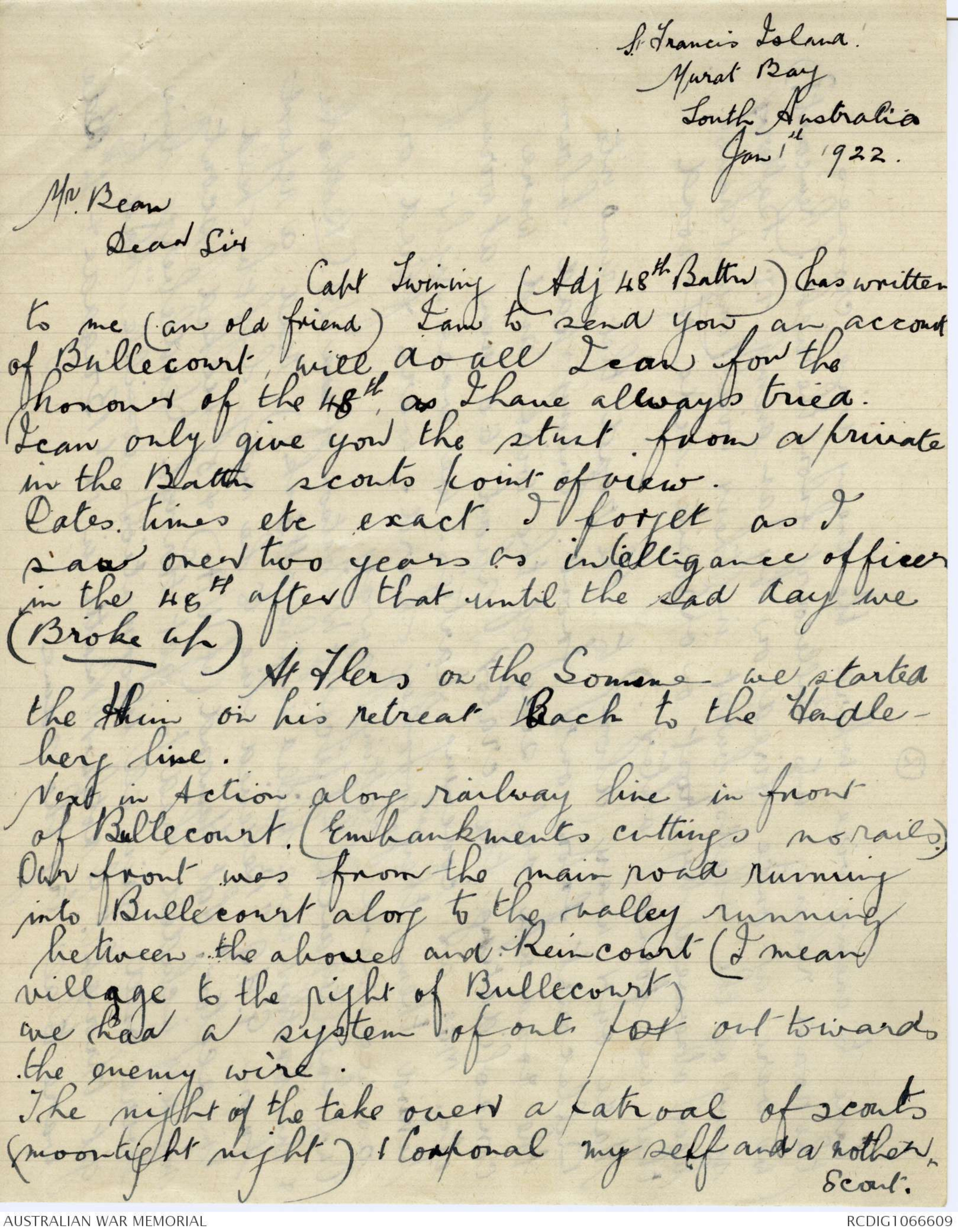

20.
This information was brought in by a man from the
47th Bn. who came over when the 46th retired.
Captain Leane then ordered at attack on the German
front line which was entered by means of the communication.
trench. About 250 yards of this trench was cleared up
after the evacuation by the 46th Bn., but owing to the
shortage of bombs on the right the 48th Bn. retired on
receipt of orders from the O.C. at about 12.30 p.m.
S.McKenzie,
2nd Lieut.
21
AUSTRALIAN IMPERIAL FORCE.
From Commanding Officer
48th Battalion
To Headquarters
12th Aust. Inf. Bde.
Report on Operation of Tanks April 11th 1917.
The Tanks on the left sector were not in position at 4.am.,
in fact at that time I saw several behind Railway Embankment.
All the Tanks did not advance on our front, only two reached
Sunken Road near “Jumping Off" Trench. These went forward
to about U 28 d 9 1, U 28 d 8 1 and opened machine-gun and
six pounder fire on the Boche trenches. They did not arrive
at this point until after 5 a.m. and remained there for some
time firing.
Our advance commenced at 5.16 not 4.45 a.m. as stated
by C.O. Tanks, and the men were exposed to heavy flank fire from
5 a.m., at which time barrage lifted off trenches East of
BULLECOURT.
The two tanks mentioned only went forward about 100 yards
and stopped again about U 28 c 2 5 , at this point the Infantry
left them and they were not seen again on our front by the
attackers. They certainly did not reach the HINDENBURG LINE
for the stakes were still standing and the wire strong. In
fact my opinion is that they never tried to do so.
The statement that they captured the HINDENBURG LINE front
and Support Trench is not correct. They were never near it
on the left sector. The only tank to go near his lines was
the one that went into the south east corner of BULLECOURT
but that was some hours after.
22.
At about 6.30 a.m. I saw a Tank near my Headquarters
on Railway Track, and told the officer in charge of it to go
to the north east corner of BULLECOURT and assist my Battalion
to clear up their left. We were being strongly counter-
attacked at this time. It was a mule tank and went forward
firing its six pounders as it moved. I watched this tank
and after going about 300 yards it turned, and returned. When
about 20 yards from my Headquarters the crew left it and rushed
to the Embankment. I inquired from the N.C.O. why he had left
it, and he said they had a direct hit, and I believe one man
was slightly wounded by the door blowing in. He said it was
going all right and could be driven away but declined to try
and the crew left for the rear. The enemy put a heavy fire on
to the Tank and about 7.30 a.m. it caught fire. I believe
this tank could have been salved had the crew possessed the
necessary pluck. They were absolutely panic-stricken when
they reached my Headquarters.
What was achieved by this Battalion was in no way due
to the assistance given by the Tanks. In fact they were a
hindrance, not a help. The men would have gone forward at
once under cover of darkness, instead of having to wait in the
open from 4 a.m. until 5.16 a.m. by which time it was daylight,
for Tanks that never advanced. Had we been able to get forward
half the casualties would have been saved.
Why the Tanks stopped and opened fire from the "Jumping
Off" Trench perhaps is best known to the O,C, Tanks. It
was certainly bad tactics because it promptly brought a
barrage right on the men waiting to advance.
I am of the opinion that the Tanks absolutely failed to
carry our their part in the attack. I consider had they shown
more dash and incentive things would have been better and
23.
perhaps we might have been still holding the line
captured today.
In the field
19/4/17
Raymond L. Leane
Lieut.-Col
Commanding 48th Battalion.
24.
AUSTRALIAN IMPERIAL FORCE.
1st Anzac Corps, 11 April, 1917.
My dear Leane,
I cannot tell you how extremely grieved I am to
have heard of your brother’s death. Words cannot express
what I fell in the matter. Having lost the one brother,
I had hoped that the rest of your family, all of whom have
done such magnificent work for the Empire, would be spared
to return to Australia, and with all the honour which has
been achieved by you all. I know that nothing that I can
say can lessen the blow, but I am sure you realise how
deeply I sympathise with you, for it is to those who
are left comes all the suffering, and I trust it may be
some small consolation to know what real brave work your
brother put in during his whole time in the A.I.F. and
how gallantly he fell.
With my deepest sympathy,
Yours very sincerely,
(Signed) W.R. BIRDWOOD,
LIEUT.-GENERAL.
COMMANDING 1ST ANZAC
TEL-CITY10900-EXT. 81
COMMONWEALTH OF AUSTRALIA
HISTORIAN
NO. 5392.
VICTORIA BARRACKS SYDNEY
22 January, 1930
Brig-General R.L. Leane, C.B., C.M.G., D.S.O., M.C., V.D.,
Chief Commissioner of Police,
Adelaide. S.A.
Dear Leane,
I have been writing the narrative of the First Battle of
Bullecourt. the records are fairly complete, but there are a few
points which puzzle me.
(1) Regarding the 48th, I think you told me that each man
carried four bombs. Lieutenant Challen and another officer
after the fight both say that each man carried two bombs.
Would your memory today enable you to clear this up?
(2) I have a note that you had a telephone communication to
Captain Leane in O.G.2 most of the time. Could you tell me
if this was by the same telephone which was used by the 46th
who also, I believe, had communication?
(3) The 46th left at 11.15, and I have a note that at 12.5 you
received "by wire"a message from Captain Leane that the
trench was becoming untenable. Could you tell me if the word
"by wire" are correct? If so, was the old telephone line
still in use after the recovery of O.G.1 by the 48th?
(4) Captain Leane's message book was brought back after the
fight. Can you tell me where it is, as I should very much like
to have the exact wording of all his messages.
(5) Your Intelligence Officer, Watson, informed you that the
Germans were reinforcing from Riencourt. Was this message
received from him by telephone after he reached the Hindenburg
Line, or was it information obtained by him from the railway
before he went? The time of the message also has some
importance.
With kind regards,
Yours sincerely
C.E.W. BEAN
[[?]]
SOUTH AUSTRALIA HN
Police Commissioner's Office.
Box383E G.P.O.
Adelaide 25th January, 1920
REFERENCE NO.
(To be quoted in reply)
C.E.W. Bean, Esq.,
Historian
Victoria Barracks
SYDNEY.
My dear Bean,
I beg to acknowledge your communication
dated January 22nd relative to incidents in the First
Battle of Bullecourt. All messages received should be
with Battalion records and the War Diary should contain
accurate record of time etc. As you know, very few of the
commissioned officers returned from the fight. Both Captain
Leane and Lieutenant Watson were killed. Lieutenant Watson
did reach Battalion lines but so badly wounded that he died
soon after reaching Hospital.
(1) I made a practice of taking two bombs per man ,
(carried on the man) when the Battalion went
into the Trenches. I knew there would be great
difficulty in getting Ammunition and Bombs
forward after the attack was launched so gave
orders that additional ammunition and four bombs
per man would be carried. This would appear
in orders. I have referred to Twining who
was my adjutant. He confirms this.
(2) A Telephone line went through the attack. This
line reached O.G.2. I received messages in the
early part of the action. One I remember was
that German Trench Mortars were giving us trouble
from a sunken road at the rear of Bullecourt.
I am of the opinion that the line was out of action
about 10 a.m. The 46 Battalion used the 48th
line for some messages. These were forwarded to
the C.O. 46th. The situation was so obscure at
10.30 a.m. that I sent the Intelligence officer,
Lieut. Watson forward to reconnoitre. He sent
back that owing to the Casualties amongst the
officers he would remain in the line.
(3) The messages I received after about 10 a.m. came back
with wounded or Runners. The 46th Battalion retired
from O.G.2 at 11.15 a.m. O.G.1 became untenable
behind the 48th in O.G.1 after the 46th vacated it.
The message came by Runner.
(4) I have no knowledge of Captain Leane's message book
-2-
being received. Any messages received during
the fight should be with Battalion records.
(5) The Germans could be plainly seen reinforcing
from Riencourt This message was received prior
to Lieut. Watson proceeding to O.G.1. I believe
the time was about 10.15 a.m.
The First Battle of Bullecourt was ill-conceived
and badly prepared for. The English who were to attack
Bullecourt never advanced. Therefore, we were placed in an
impossible position. the was no artillery preparation or
support. The Tanks failed dismally. Only one tank ever
reached O.G.2. One apparently lost direction and went into
Bullecourt when it was captured. Another turned when just
in front of my Headquarters on the Railway line. The crew
jumped out of the tank and returned retired. Fairley, my Signalling
Officer, was sniped from Bullecourt endeavouring to shift
this Tank.
I have read, with pleasure, your last volume. It
is wonderful that you have been able to obtain such splendid
record of the A.I.F. Unfortunately War records were not
perhaps as carefully kept as should have been the case and many
important documents were lost in transit.
Congratulations! The history when completed
will be a great achievement.
With kind regards to Mrs. Bean and yourself.
Yours faithfully,
Raymond Leane
Commissioner of Police.
St.Francis Island
Murat Bay
South Australia
Jan 1st 1922
Mr Bean
Dear Sir,
Capt. Twining (Adj 48th Battn) has written
to me (an old friend) I am to send you an account
of Bullecourt, will do all I can for the
honour of the 48th, as I have always tried.
I can only give you the start from a private
in the Battn scouts point of view.
Dates, times etc exact I forget as I
saw over two years as intelligence officer
in the 48th after that until the sad day we
(Broke up)
At Flers on the Somme we started
the Hun on his retreat back to the Hendleberg
line.
Next in Action along railway line in front
of Bullecourt. (Embankments cuttings nor rails)
Our front was from the main road running
into Bullecourt along the valley running
between the above and Reincourt (I mean
village to the right of Bullecourt)
we had a system of outs for out towards
the enemy wire.
The night of the take over a patrol of scouts
(moonlight night) 1 Corporal myself and another scout.
2
Came to enemy wire where the enemy wire crosses
the road running into Bullecourt from the right (Reincourt?),
we were at once fired on by an enemy 77 Battery
many of the shells burst in their wire (must have
been observed by post on opposite side of road
that we found after)
Made our way along to the road that runs into
Bullecourt from our front. Enemy had blown
the road up out side of the wire and were
consolidating the crater about 60 men at wiring
etc M.Gs as covering parties. We were right
behind them, they were working hard, & were fired on
as we were getting away.
Our Intelligence Officer L.W.Watson of W.A. (Both he
& his brother were killed in the attack) read a report
from G.H.Q. "Believed line to be very lightly held
in sector; Sgt. Hammond (of W.A.) & 5 picked scouts
myself included had to get through Hendleberg line
wire and gain all information possible, "had to
get through" Another Battn in 12th Brigade & 4th Bde
were to all try the same.
 Sandy Mudie
Sandy MudieThis transcription item is now locked to you for editing. To release the lock either Save your changes or Cancel.
This lock will be automatically released after 60 minutes of inactivity.